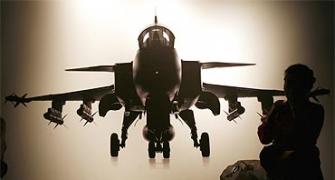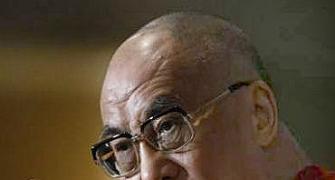This will continue to constrain India's rise as a major regional and global player of any significance, says Harsh V Pant.
China has declared that its official defence budget for 2011 will rise by 12.7 percent from the previous year. Last year there was a lot of hoopla surrounding the fact that China had announced a mere 7.5 percent jump in its defence budget. It was the first time since the 1980s that China's defence spending increased in single-digit percentage. But this year we are back to the norm of double digit increases.
While the civilian leadership in China has tried to downplay the latest increase suggesting that much of the increase will go to human resources development, infrastructure and training, it is the response of the Chinese military that should be a matter of concern.
The military spokesman, Major General Luo Yuan, was unambiguous in suggesting that when it comes to military spending, there is no need for China 'to care about what others may think.' The international community has long demanded that China should be more transparent about the intentions behind its rapid defence spending. Now the Chinese military is making its strategic intent clear.
Divisions within China about the future course of nation's foreign policy are starker than ever before. It is now being suggested that much like young Japanese officers in the 1930s, young Chinese military officers are increasingly taking charge of strategy with the result that rapid military growth is shaping nation's broader foreign policy objectives.
Civil-military relations in China are under stress with the People's Liberation Army asserting its pride more forcefully than even before and demanding respect from other states. 'A country needs respect, and a military also needs respect,' wrote a major general last year in the PLA's newspaper. Not surprisingly, China has been more aggressive in asserting its interests not only vis-a-vis India but also vis-a-vis the US, the European Union, Japan and South-East Asian States.
The increasing assertion by the Chinese military and changing balance of power in the nation's civil-military relations should be a real cause of concern for China's neighbours. The pace of Chinese military modernisation has already taken the world by surprise and it is clear that the process is going much faster than many had anticipated.
A growing economic power, China is now concentrating on the accretion of military might so as to secure and enhance its own strategic interests. China, which has the largest standing army in the world with more than 2.3 million members, continues to make the most dramatic improvements in its nuclear force among the five nuclear powers and improvements in its conventional military capabilities are even more impressive.
What has been causing concern in Asia and beyond is the opacity that seems to surround China's military build-up, with an emerging consensus that Beijing's real military spending is at least double the announced figure.
The official figures of the Chinese government do not include the cost of new weapon purchases, research or other big-ticket items for China's highly secretive military and as a result, the real figures are much higher than the revealed amount.
Despite this, India's defence modernisation programme is faltering. This year the Indian government has allocated only 1.8 percent of the GDP to defence, though ostensibly the military expenditure has gone up by 11.58 percent. This is only the second time in over three decades that the defence to GDP ratio has fallen below 2 percent of the GDP.
This is happening at a time when India is expected to spend $112 billion on capital defense acquisitions over the next five years in what is being described as 'one of the largest procurement cycles in the world.' Indian military planners are shifting their focus away from Pakistan as China takes centre-stage in future strategic planning.
Over the past two decades, the military expenditure of India has been around 2.75 percent but since India has been experiencing significantly higher rates of economic growth over the last decade compared to any other time in its history, the overall resources that it has been able to allocate to its defence needs has grown significantly.
The armed forces for long have been asking for an allocation of 3 percent of the nation's GDP to defence. This has received a broad political support in recent years. Indian Prime Minister Manmohan Singh has been explicit about it, suggesting that 'if our economy grows at about 8 percent per annum, it will not be difficult for (the Indian government) to allocate about 3 percent of GDP for national defence.'
Parliament has also underlined the need to aim for the target of 3 percent of GDP. Yet as a percentage of GDP, the annual defence spending has declined to one of its lowest levels since 1962.
But defence expenditure alone will not solve all the problems plaguing Indian defence policy. More damagingly, for the last several years now the defence ministry has been unable to spend its budgetary allocation, this year being an exception. The defence acquisition process remains mired in corruption and bureaucratese.
A series of defence procurement scandals since late 1980s have also made the bureaucracy risk averse, thereby delaying the acquisition process. A large part of the money is surrendered by the defence forces every year given their inability to spend due to labyrinthine bureaucratic procedures involved in the procurement process.
India's indigenous defence production industry has time and again made its inadequacy to meet the demands of the armed forces apparent. The Indian armed forces keep waiting for arms and equipment while the finance ministry is left with an unspent budget year after year. Most large procurement programmes get delayed resulting in cost escalation and technological or strategic obsolescence of the budgeted items.
The Indian government is yet to demonstrate the political will to tackle the defence policy paralysis that seems to be rendering all the claims of India's rise as a military power increasingly hollow.
The capability differential between China and India is rising at an alarming rate. This will continue to constrain India's rise as a major regional and global player of any significance.
Harsh V Pant is the author of The China Syndrome (HarperCollins).









